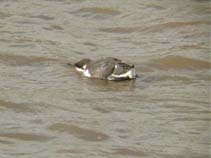Alca torda Linnaeus, 1758
Razorbill
Classification / Names Common names | Synonyms | CoL | ITIS | WoRMS
Aves | Charadriiformes | Alcidae
Environment: milieu / climate zone / depth range / distribution range Ecology
Others; depth range 0 - 120 m (Ref. 62202). Polar; 82°N - 27°N, 80°W - 43°E (Ref. 124582)
Distribution Countries | FAO areas | Ecosystems | Occurrences | Introductions
Northwest Atlantic, Eastern Atlantic and the Arctic: Polar to temperate.
Length at first maturity / Size / Weight / Age
Maturity: Lm ? range ? - ? cm Max length : 45.0 cm TL male/unsexed; (Ref. 8812); max. published weight: 719.00 g (Ref. 356)
Short description Morphology
Culmen: 3.45 cm; tarsus: 2.963 cm; wing: 21.13 cm.
Total Length: 40 to 45 cm; Wingspan: 63 to 66 cm (Ref. 8812). Found along coasts; <15 km (Ref. 356). In the North Sea off the east coast of Scotland and northern England, this species primarily forage inshore and feed on the sandeel, Ammodytes marinus (Ref. 95711). Known to be pursuit divers (Ref. 356). They surface-feed by scooping prey from the water and also able to exploit the water column by diving; carrying prey in their bills back to their colony. In nesting colonies, breeding pairs share incubation and chick-rearing duties. Adults feed their chicks with regurgitated food (Ref. 95711).
Life cycle and mating behavior Maturity | Reproduction | Spawning | Eggs | Fecundity | Larvae
Breeds from northern Europe east to Russia, Iceland, Greenland, and coastal North America from Baffin Island south to the Maritime Provinces and Maine. Winters from Greenland south even to South Carolina, and in Europe to the Mediterranean. Eggs are laid from early June to early August (Ref. 87872).
Main reference
References | Coordinator | Collaborators
Camphuysen, C.J.K. 1998. (Ref. 7319)
IUCN Red List Status (Ref. 130435)
Least Concern (LC) ; Date assessed: 17 August 2021
CITES status (Ref. 108899)
Not Evaluated
CMS (Ref. 116361)
Not Evaluated
Threat to humans
Human uses
| FishSource |
Tools
More information
Internet sources
BHL | BOLD Systems | CISTI | DiscoverLife | FAO(Publication : search) | Fishipedia | GenBank (genome, nucleotide) | GloBI | Gomexsi | Google Books | Google Scholar | Google | PubMed | Tree of Life | Wikipedia (Go, Search) | Zoological Record
Estimates based on models
Preferred temperature
(Ref. 115969): 2.3 - 12.7, mean 8.1 (based on 1259 cells).
Resilience
(Ref. 69278):
High, minimum population doubling time less than 15 months (K=20.71-50.32).
Price category
(Ref. 80766):
Unknown.



